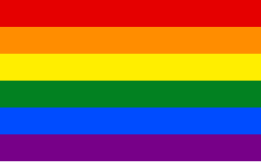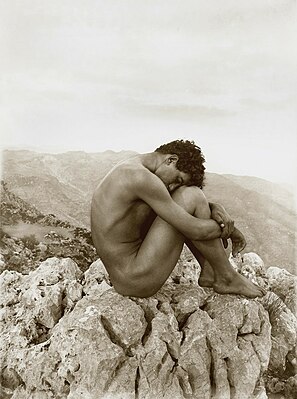Portal:LGBTQ
| Main page | WikiProjects & Things you can do |

|
The LGBTQ+ Portal |

|

|

|
Introduction Same-sex couple holding hands  LGBTQ (also commonly seen as LGBT, LGBT+, LGBTQ+, LGBTQIA, and LGBTQIA+) is an initialism for lesbian, gay, bisexual, transgender and queer or questioning. It is an umbrella term, originating in the United States, broadly referring to all sexualities, romantic orientations, sex characteristics, and gender identities that are not heterosexual, heteroromantic, cisgender, or endosex. In the 1990s, gay, lesbian, and bisexual activists adopted the initialism LGB. Terminology eventually shifted to LGBT, as transgender people gained recognition. Around that time, some activists began to reclaim the term queer, seeing it as a more radical and inclusive umbrella term, though others reject it, due to its history as a pejorative. In recognition of this, the 2010s saw the adoption of LGBTQ, and other more inclusive variants. (Full article...)
Selected article - The Washington Blade is an LGBT newspaper in the Washington metropolitan area. The Blade is the oldest LGBT newspaper in the United States and third largest by circulation, behind the Philadelphia Gay News and the Gay City News of New York City. The Blade is often referred to as America's gay newspaper of record because it chronicled LGBT news locally, nationally, and internationally. The New York Times said the Blade is considered "one of the most influential publications written for a gay audience." The paper was originally launched as an independent publication in October 1969 with a focus on bringing the community together. In 2001, the Blade was purchased by Window Media LLC, a group of gay-oriented newspapers circulated throughout the United States with a staff composed of professional journalists, becoming a leading source of news for the readers both in Washington and around the nation. The paper publishes weekly on Fridays and celebrated its 50th anniversary in October 2019. (Full article...) Selected biography -Ann Weldy (born September 15, 1932), better known by her pen name Ann Bannon, is an American author who, from 1957 to 1962, wrote six lesbian pulp fiction novels known as The Beebo Brinker Chronicles. The books' enduring popularity and impact on lesbian identity has earned her the title "Queen of Lesbian Pulp Fiction". Bannon was a young housewife trying to address her own issues of sexuality when she was inspired to write her first novel. Her subsequent books featured four characters who reappeared throughout the series, including her eponymous heroine, Beebo Brinker, who came to embody the archetype of a butch lesbian. The majority of her characters mirrored people she knew, but their stories reflected a life she did not feel she was able to live. Despite her traditional upbringing and role in married life, her novels defied conventions for romance stories and depictions of lesbians by addressing complex homosexual relationships. Her books shaped lesbian identity for lesbians and heterosexuals alike, but Bannon was mostly unaware of their impact. She stopped writing in 1962. Later, she earned a doctorate in linguistics and became an academic. She endured a difficult marriage for 27 years and, as she separated from her husband in the 1980s, her books were republished; she was stunned to learn of their influence on society. They were released again between 2001 and 2003 and were adapted as an award-winning Off-Broadway production. They are taught in women's and LGBT studies courses, and Bannon has received numerous awards for pioneering lesbian and gay literature. She has been described as "the premier fictional representation of US lesbian life in the fifties and sixties", and it has been said that her books "rest on the bookshelf of nearly every even faintly literate Lesbian". (Full article...) Selected quote -
—Ed Fallon, on same-sex marriage
Current events
Selected image - Wilhelm von Gloeden (1856–1931) was a German photographer living on Sicily in the late 19th century. He specialized in pastoral nude photography of the local youths, selling his prints to tourists such as Oscar Wilde. Caino (1902) is among his most famous works—an homage to the painting Young Male Nude Seated beside the Sea (1832) by Jean-Hippolyte Flandrin. Later photographers such as Cecil Beaton and Bruce Weber were influenced by von Gloeden's aesthetic.
Did you know… -
This month's birthdays
Selected listsRelated portalsFeatured contentThe following articles and lists have been identified as some of the best produced by the Wikipedia community:
TopicsCategoriesAssociated WikimediaThe following Wikimedia Foundation sister projects provide more on this subject:
Discover Wikipedia using portals |
























